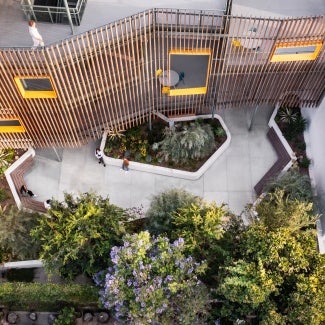Rose Villa Senior Living Phase 3
The award-winning design for Rose Villa Senior Living in Portland, Oregon offers common space for neighbors to engage while retaining aesthetic and functional differences unique to each building on the garden campus.

Project highlights: Rose Villa Senior Living Phase 3
- Architect: Scott Edwards Architecture and Gawron Turgeon Architects
- Owner: Rose Villa Senior Living
- Location: Portland, Oregon
- Category: Special Recognition
This project expands the centralized “urban” core of Rose Villa Senior Living, a 22-acre garden campus in Portland, Oregon, that has reimagined senior living communities. The development functions much like a small town organized around campus amenities and adds two new buildings, Schroeder Lofts and Madrona Grove, to its southern end.
At first glance, the two new buildings may seem like separate projects, but they are connected below grade and were designed, permitted, and constructed simultaneously. Though they are expressed as discrete typologies with differing aesthetic characteristics, the two buildings, which share a landscaped courtyard that encourages neighbors to interact, still feel related.
Schroeder Lofts is a five-story, wood-framed multi-use building with below-grade parking, amenities, a child care facility, and 35 independent living lofts. A palpable sense of outdoor living is prompted by oversized windows, garden terraces, and balconies that further activate the neighborhood. On its first floor, community spaces are connected by a covered arcade that draws the sidewalk into the building. The central hub for those spaces is a recreation room that doubles as a lounge, game room, and teaching kitchen. Also along the arcade is a medical clinic, quilting club room, and a resident-operated second-hand shop called Treasure House.
The steel-framed Madrona Grove includes a two-story licensed residential long-term care facility fronted by a welcoming front porch and public cafe. Its two residential floors include a nursing facility and residential care facility across 32 private rooms. Its floors are inspired by the concept of a small home with groups of rooms, or households, constituting neighborhoods, each with its own common kitchen, dining, and living room spaces connected to the outdoors. To reinforce the concept of home, the interior design relies on restful but vibrant colors, comfortable furniture, and residential-style lighting.
This project emerged from carefully researched design solutions, close collaborations among the project team, and tremendous care from all parties. The overarching value of connection and independent living informed each phase of the design, from space planning to landscaping. Overall, this expansion has advanced the common understanding of senior living and offers replicable approaches for future projects.
Framework for Design Excellence Measures
Was there a design charrette? Yes
Site area that supported vegetation (landscape or green roof) pre-development: 28%
Site area that supports vegetation post-development: 32%
Site area covered by native plants supporting native or migratory species and pollinators: 32%
Strategies used to promote Design for Ecosystems: Biodiversity, Dark skies
Is potable water used for irrigation? Yes
Is potable water used for cooling? No
Is grey/blackwater reused on-site? Yes
Is rainwater collected on-site? No
Stormwater managed on-site: 100%
2030 Commitment baseline EUI: 53 kBtu/sf/yr
Predicted net EUI including on-site renewables: 32 kBtu/sf/yr
Reduction from the benchmark: 40%
Is the project all-electric? No
Level of air filters installed: MERV 12-14
Was a “chemicals of concern” list used to inform material selection? Yes
Do greater than 90% of occupied spaces have a direct view to the outdoors? Yes
Were embodied carbon emissions estimated for this project? Yes
Estimated service life: 100 years
Ability to survive without utility power: Partial back-up power
Has a post-occupancy evaluation been conducted? No, and a POE will not be conducted.
Building performance transparency steps taken:
* Present the design, outcomes, and/or lessons learned to the office,
* Present the design, outcomes, and/or lessons learned to the profession,
* Publish lessons learned from design, construction, and/or occupancy.
Project team & Jury
Year of substantial project completion: 2022
Gross conditioned floor area: 111,818 sq. ft.
Architect: Scott Edwards Architecture
Associate Interior Architect: Gawron Turgeon Architects (Madrona Grove Levels 1 and 2)
Engineer - Civil: Humber Design Group, Inc.
Engineer - MEP: Interface Engineering, Inc.
Engineer - Structural: WDY, Inc
Engineer - Water: Biohabitats (ROSIE Water Filtration System)
Food Service Consultant for Madrona Grove: JBK Consulting and Design, Inc.
General Contractor: Bremik Construction
Interior Designer: Scott Edwards Architecture (Madrona Grove Level 3 and Schroeder Lofts)
Landscape Architect: Shapiro Didway LLC
Jennifer Sodo, AIA, Chair, EUA, Milwaukee
Winifred Elysse Newman, Assoc. AIA, Clemson University, Clemson, S.C.
Philippe Saad, AIA, DiMella Shaffer, Boston
Margaret Suit, Erickson Senior Living, Catonsville, Md.
Lisa Warnock, Glow Interior Designs, Portland, Ore.
The Design for Aging Review showcases facilities that represent conscientious surroundings and advance environments for senior living.
Five projects showcase the best in senior living communities.













